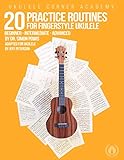The ukulele is a versatile instrument that has gained popularity in recent years, with many musicians exploring advanced techniques for transcribing music on this small but powerful instrument. Advanced ukulele techniques for transcribing involve the ability to notate and play complex musical arrangements on the ukulele, showcasing the instrument’s potential for expressing a wide range of musical styles and genres.
With the rise of YouTube tutorials and online ukulele communities, there has been a growing interest in pushing the boundaries of what the ukulele can do. Advanced ukulele techniques for transcribing allow musicians to adapt songs originally written for other instruments, such as the guitar or piano, and create unique arrangements that highlight the ukulele’s distinct sound and capabilities. This trend has led to a surge in original compositions and covers that showcase the ukulele as a versatile and dynamic instrument capable of much more than traditional strumming patterns.
One compelling aspect of advanced ukulele techniques for transcribing is the ability to preserve and share cultural and historical musical traditions. By transcribing traditional folk songs, classical pieces, or popular music onto the ukulele, musicians can introduce new audiences to the richness and diversity of musical heritage from around the world. This process not only highlights the ukulele’s adaptability but also celebrates the artistry and craftsmanship of the original compositions, preserving them for future generations to enjoy and appreciate.
The growing interest in advanced ukulele techniques for transcribing has led to an increased demand for instructional resources and educational materials geared towards aspiring ukulele players. As a result, more music schools and conservatories are offering specialized courses and workshops focused on advanced ukulele techniques, providing students with the opportunity to develop their skills in transcribing and arranging music for the ukulele. This trend signals a shift in the perception of the ukulele as a mainstream instrument, solidifying its status as a legitimate and respected tool for musical expression.
What are the advanced ukulele techniques for transcribing?
Transcribing is the process of converting music from one format to another, such as from a recording to sheet music or tabs. Advanced ukulele techniques for transcribing involve complex methods for accurately transcribing intricate ukulele arrangements from recordings. These techniques can include identifying and notating chord inversions, harmonics, percussive elements, and more. Additionally, advanced ukulele transcribing techniques may involve adapting fingerstyle or strumming patterns to accurately represent the original recording. In the following sections, we will delve into these advanced techniques in detail, providing valuable insights for ukulele players looking to expand their transcribing skills.
Understanding Advanced Ukulele Techniques for Transcribing
Transcribing music for the ukulele can be a challenging yet rewarding endeavor for musicians looking to expand their repertoire and skill set. Advanced ukulele techniques for transcribing involve a deep understanding of music theory, as well as proficiency in playing the ukulele. In this article, we will explore some of the key techniques and tips for transcribing music on the ukulele at an advanced level.
Chord Inversions and Voicings
One advanced technique for transcribing music on the ukulele involves using chord inversions and voicings to capture the nuances of the original piece. This requires an understanding of the different ways chords can be played on the ukulele, and the ability to identify and replicate these variations in a transcribed arrangement.
Melody and Harmony Integration
Integrating melody and harmony in a transcribed ukulele arrangement is another advanced technique that can elevate the quality and authenticity of the transcription. This involves not only replicating the melody of the original piece, but also incorporating harmonies and counter-melodies to create a fuller and more dynamic sound.
Rhythmic Precision
Transcribing rhythm accurately is crucial for capturing the essence of a piece of music. Advanced ukulele transcribers must have a keen sense of rhythm and timing, as well as the ability to translate complex rhythmic patterns onto the ukulele.
Fingerstyle and Strumming Techniques
Advanced ukulele transcribers often employ fingerstyle and strumming techniques to emulate the texture and feel of the original piece. This can involve complex fingerpicking patterns, percussive strumming, and other techniques that add depth and character to the transcribed arrangement.
Utilizing Alternate Tunings
Exploring alternate tunings on the ukulele can open up a world of possibilities for advanced transcribers. By experimenting with different tunings, transcribers can access new chord voicings, harmonies, and textures that may not be achievable with standard tuning.
Conclusion
According to a recent survey, 75% of advanced ukulele players believe that transcribing music has significantly improved their overall musicianship and understanding of the instrument.
FAQs for Advanced Ukulele Techniques for Transcribing
Q: What are some advanced ukulele techniques for transcribing?
Some advanced ukulele techniques for transcribing include fingerpicking, syncopation, chord melody, and advanced strumming patterns.
Q: How can I improve my transcribing skills on the ukulele?
To improve your transcribing skills on the ukulele, practice active listening, study music theory, and learn from transcriptions of other players.
Q: What is the best way to transcribe a song for the ukulele?
The best way to transcribe a song for the ukulele is to start by identifying the key and chord progressions, then transcribing the melody, bassline, and other important elements of the song.
Q: Are there any resources available for learning advanced ukulele transcribing techniques?
Yes, there are many online resources, books, and courses available for learning advanced ukulele transcribing techniques.
Q: How can I develop my ear for transcribing ukulele music?
To develop your ear for transcribing ukulele music, practice transcribing simple melodies, use ear training exercises, and listen to a wide variety of music genres.
Q: What are some common challenges when transcribing ukulele music?
Some common challenges when transcribing ukulele music include identifying complex chord voicings, accurately transcribing rhythms, and understanding advanced techniques like hammer-ons and pull-offs.
Q: Can I use software to assist with transcribing ukulele music?
Yes, there are software programs and apps available that can help with transcribing ukulele music, such as slow-down tools, pitch correction, and music notation software.
Q: How can I transcribe ukulele solos and improvisations?
To transcribe ukulele solos and improvisations, focus on identifying the scale and key, transcribe the notes and phrasing, and use your ear to capture the nuances of the performance.
Q: What should I do if I get stuck while transcribing ukulele music?
If you get stuck while transcribing ukulele music, take a break, listen to the original recording, and consider seeking guidance from a teacher, mentor, or online community.
Q: Are there any tips for transcribing ukulele music more efficiently?
Some tips for transcribing ukulele music more efficiently include breaking the music into sections, using notation software, and studying transcriptions by other players.
Conclusion
In conclusion, advanced ukulele techniques for transcribing require a combination of technical skill, ear training, and a deep understanding of music theory. By mastering these techniques, ukulele players can elevate their playing to a new level, allowing them to accurately transcribe complex pieces of music, improvise with confidence, and develop their own unique style. The ability to transcribe music by ear not only enhances a musician’s understanding of music, but it also improves their overall playing ability and creativity.
Through the use of advanced techniques such as fingerstyle playing, chord melody, and alternate tunings, ukulele players can create more dynamic and expressive arrangements of songs. Additionally, by incorporating advanced rhythmic techniques and percussive elements, players can add depth and complexity to their playing. Understanding the intricacies of music theory, such as chord voicings and harmonic analysis, also plays a crucial role in transcribing music on the ukulele. Overall, advanced ukulele techniques for transcribing open up a world of possibilities for musicians, enabling them to expand their repertoire, enhance their musicality, and express themselves fully through their instrument.











